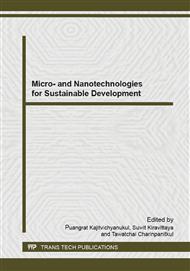p.1
p.9
p.15
p.21
p.29
p.37
p.45
p.53
Development of Chemical Sensor Array for Rice Aroma Detection
Abstract:
Gas sensor array based on polymer/multi-walled carbon nanotubes (polymer/MWCNTs) composites prepared by screen printing technique was examined for rice aroma detection. The sensor array consists of two sets of three different sensors, i.e., MWCNTs dispersed in the matrix of poly (2-Acrylamido-2-methyl-1-propanesulfonic acid-co-acrylonitrile (S1-S2), polyvinyl alcohol (S3-S4) and poly (styreneco-maleic acid) partial isobutyl/methyl mixed ester (S5-S6). Sample temperature, which is one of the important parameters, has been found to influence the releasing rate of the volatiles from rice grain when needed to operate on the electronic nose system. In this case, the fabricated sensor array installed within a lab-made electronic nose system with optimum sample temperature at 70°C could provide rapid and best responses to the volatiles released from the milled rice sample. Moreover, the responsive signals could be recovered to original state as well within four minutes by only purging with fresh air at room temperature. Based on the principal component analysis (PCA) pattern recognition, it was shown that the electronic nose can discriminate six rice samples based on the content of aroma.
Info:
Periodical:
Pages:
15-20
Citation:
Online since:
May 2015
Authors:
Keywords:
Price:
Сopyright:
© 2015 Trans Tech Publications Ltd. All Rights Reserved
Share:
Citation:


